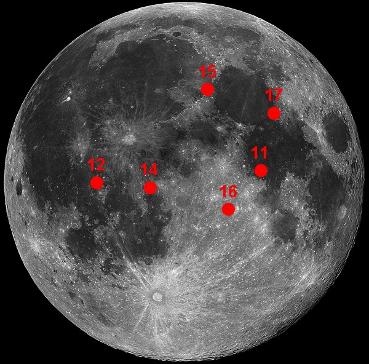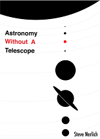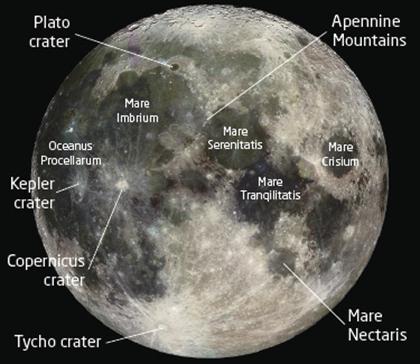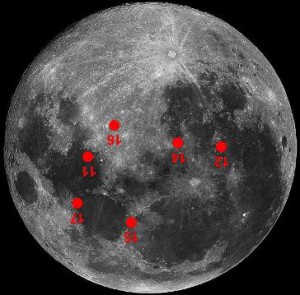Lunar maps
Some of the Moon’s prominent features visible with the naked eye. The Maria (plural of Mare), are often translated as Seas, such as the Sea of Tranquility, the landing site of Apollo 11. The Maria are giant impact craters subsequently filled by pools of lava which cooled to form the dark basalt plains we see today.
The Apennine Mountains (some as high as four kilometres) are just an uplifted dividing edge between Imbrium and Serentatis impact craters—unlike mountains of Earth which are the result of plate tectonics and/or volcanoes.
Samples returned by Apollo from the Mare have higher levels of iron and titanium than ‘highland’ samples representative of the lighter areas of the Moon’s surface. This is probably a result of the lava flows bringing heavier elements from the Moon’s core up to the surface.
A common rock outside the Maria is anorthosite, which is sometimes described as the scum that forms on the surface of a ‘magma ocean’— which then becomes surface rock when that ocean cools.
The accumulated evidence of Apollo samples, a few lunar meteorites and samples retuned by the Russian Luna 16, 20 and 24 missions suggests the Moon begun its life as a liquid ball of rock, which cooled and then did little else geologically, apart from being hit by meteors large and small for over 3 billion years.
Translated place names:
· Mare Tranquillitatis: The Sea of Tranquility
· Mare Crisium: The Sea of Crises (i.e. more than one crisis)
· Mare Nectaris: The Sea of Nectar
· Mare Serenitatis: The Sea of Serenity
· Mare Imbrium: The Sea of Rains
· Oceanus Procellarum: The Ocean of Storms
Crater people:
· Plato: the first recorded person to say astronomy should be a science needing high level mathematics and geometry
· Nicolaus Copernicus: who achieved pretty much everything Plato had been thinking of
· Tycho Brahe: (the great data collector, it was Scandinavian custom at that time that your first name was your formal name)
· Johannes Kepler: who used Tycho’s data to form his Laws of Planetary Motion.

The Apollo landing sites
· 11 Mare Tranquillitatis July 20, 1969
· 12 Oceanus Procellarum Nov. 19, 1969
· 14 Fra Mauro Feb. 5, 1971 (Apollo 13 had planned to land in this region)
· 15 Hadley-Apennines July 30, 1971
· 16 Descartes April 21, 1972
· 17 Taurus-Littrow Dec. 11, 1972.
Southern Hemisphere translation guide:
Below is a shot of how the Moon would look from the Southern hemisphere, with Mare Crisium to the lower left.
Being down under means we see the Moon the other way up—unless you’re looking through an astronomical telescope in which case the Moon will look like the diagram above.






